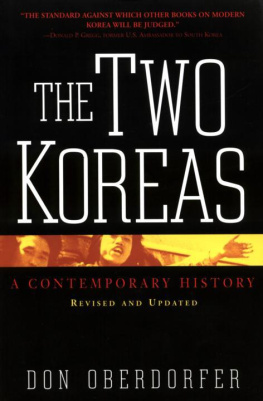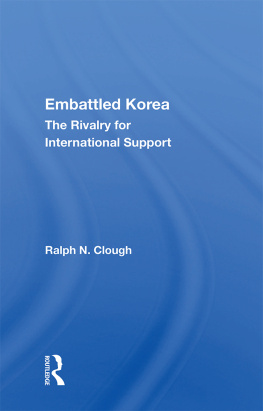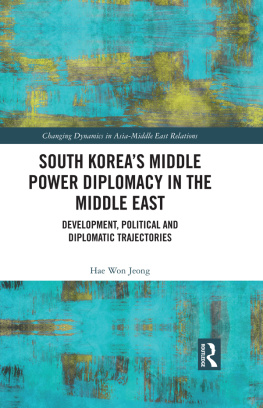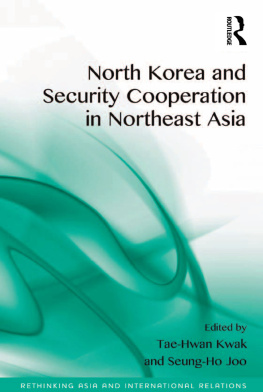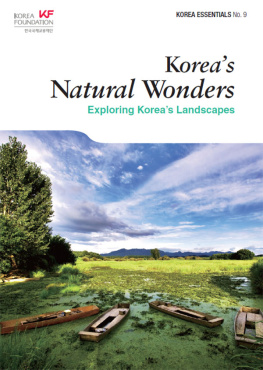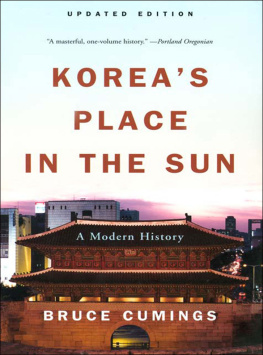Don Oberdorfer - The two Koreas: a contemporary history
Here you can read online Don Oberdorfer - The two Koreas: a contemporary history full text of the book (entire story) in english for free. Download pdf and epub, get meaning, cover and reviews about this ebook. year: 2001, publisher: Basic Books, genre: Science. Description of the work, (preface) as well as reviews are available. Best literature library LitArk.com created for fans of good reading and offers a wide selection of genres:
Romance novel
Science fiction
Adventure
Detective
Science
History
Home and family
Prose
Art
Politics
Computer
Non-fiction
Religion
Business
Children
Humor
Choose a favorite category and find really read worthwhile books. Enjoy immersion in the world of imagination, feel the emotions of the characters or learn something new for yourself, make an fascinating discovery.
- Book:The two Koreas: a contemporary history
- Author:
- Publisher:Basic Books
- Genre:
- Year:2001
- Rating:5 / 5
- Favourites:Add to favourites
- Your mark:
- 100
- 1
- 2
- 3
- 4
- 5
The two Koreas: a contemporary history: summary, description and annotation
We offer to read an annotation, description, summary or preface (depends on what the author of the book "The two Koreas: a contemporary history" wrote himself). If you haven't found the necessary information about the book — write in the comments, we will try to find it.
The two Koreas: a contemporary history — read online for free the complete book (whole text) full work
Below is the text of the book, divided by pages. System saving the place of the last page read, allows you to conveniently read the book "The two Koreas: a contemporary history" online for free, without having to search again every time where you left off. Put a bookmark, and you can go to the page where you finished reading at any time.
Font size:
Interval:
Bookmark:

THE
TWO
KOREAS
OTHER BOOKS BY DON OBERDORFER
Tet!
The Turn: From the Cold War to a New Era
Princeton University: The First 250 Years
TWO
KOREAS
A CONTEMPORARY HISTORY
New Edition
Don Oberdorfer




For the people of the two Koreas May they be one again, and soon.
CONTENTS
Xi
xvii
I

PREFACE TO THE NEW EDITION
We are now traveling the length of free Korea by troop train, from the southern tip, the port of Pusan, to almost the farthest point therefrom, Inchon on the northwest coast ... Our first impressions, at Pusan, were miserable and pathetic. The dirtiest children I have ever seen anywhere evaded MPs around the train to beg from GIs. One boy crawled around the train on his only leg; what had been his left one was off at the thigh. When our train pulled out, several boys threw rocks at the train ... Out of Pusan, however, the picture is better. The Korean countryside is quite mountainous, with villages in the little stretches of valleys between the rugged, unadorned crags. The people in the villages till the soil and wash in the muddy water holes, and the children do God-knows-what. They line the sides of the railroad and shout, "hello, hello" at the troop train, hoping to be thrown cigarettes or candy or something of value.-FROM MY DIARY, August 11, 1953This was my introduction to Korea as a U. S. Army lieutenant weeks after the armistice which ended the bloody three-year war on the peninsula, and the beginning of a lifelong interest in an embattled and amazing country. In my field artillery unit just south of the ceasefire line, we were dug in and ready to renew the battle against heavily armed North Korean units stationed across the hills only a mile or two away. We did not know how fragile or hardy the armistice would be or how long the truce would hold, but none of us would have believed that the state of no-war, no-peace would persist into the twenty-first century.The massively fortified strip bisecting the Korean peninsula was one of the world's most dangerous potential flashpoints throughout the cold war. Although the barriers have come down nearly everywhere else, at this writing Korea remains-as President Bill Clinton said in his 1997 State of the Union address-"the Cold War's last divide." The misnamed "demilitarized zone," a verdant but heavily mined sanctuary for wild birds and animals, continues to be the focal point of the most powerful concentrations of opposing military forces of the post-cold war world despite both secret and open attempts at reconciliation. Close to 2 million troops, including 37,000 from the United States who would be instantly involved in new hostilities, are on duty in North or South Korea, with many on hair-trigger alert wielding powerful weapons of war. Today, despite dramatic and hopeful recent developments, American overseas commitments and military forces are at greater risk at the Korean DMZ than anywhere else on earth.While the confrontation across the DMZ continues, almost everything else has changed dramatically. South of the dividing line, the Republic of Korea has developed since the 1970s into an economic powerhouse. By 1997 it was the world's eleventh largest economy and one of the foremost producers of ships, automobiles, electronics, steel, and a host of other goods, with a per capita income of more than $10,000 per year. By that time its fiesty democracy had thrown off all vestiges of military rule and imprisoned the two generals who had led the country in the 1980s. Late in 1997, it was suddenly beset by a massive financial crisis that began in Southeast Asia. In this atmosphere it elected longtime opposition leader Kim Dae Jung as its president for the next five years. He immediately set about to stabilize and reform the economy, and undertake new and positive engagement toward the North. Although economic reform is still incomplete, his determined and persistent policy toward the North paid off in an unprecedented summit meeting in June 2000 and the promise of extensive NorthSouth interaction in economic, political, and even military fields.North of the dividing line, the Democratic People's Republic of Korea, which developed its own unique brand of communist Confucianism, remains militarily powerful but has lost the race in every other way. Early in the 1990s North Korea was abandoned by its former sponsor and ally, the Soviet Union, which established close relations with South Korea and then collapsed, and was devalued by its other major sponsor and ally, China, which became more interested in markets than in Marxism. Following the death of its founding leader in 1994, North Korea suffered a sharp economic decline, which was a central factor in a famine in outlying areas that led to massive loss of life.Under the successor leadership of the enigmatic Kim Jong 11, the eldest son of the founder, Pyongyang was forced to turn to the outside world for humanitarian assistance in the mid-1990s. Late in the decade North Korea undertook new policies of engagement with South Korea, the United States, and a variety of other Asian and European countries. At this writing, it is yet uncertain whether Kim Jong I1's limited opening and cautious domestic reforms will continue and, if so, whether these actions will bring about a revival of the North Korean economy and secure the survival of the regime. In the preface to earlier editions of this book, I wrote that it seemed unlikely that the DPRK could survive in its existing form without such major changes. As risky as they may be, the North's new policies, I believe, have improved its odds.I have sought to record here the ways in which the two halves of this ancient and homogeneous people, thoughtlessly divided at the end of World War II by the great powers, have grappled with each other for advantage and supremacy in the past three decades, and how they have dealt with the powerful forces all around them. The course of their struggle, like those that enveloped the Korean peninsula for many centuries past, has been deeply affected by actions of the surrounding powers-China, Japan, and Russia. Since World War II and especially since the Korean War, in which nearly 1,500,000 Americans served and 36,000 Americans were killed, the United States has played a major role. Korea is the only country in the world where the interests and security concerns of these four powers directly intersect. Although the major powers have had a large impact on Korea's fate, the hardy, gutsy, independent-minded Koreans on both sides of the DMZ have demanded and won for themselves important roles. Beginning with the North-South summit meeting of June 2000, they have begun to take their future into their own hands as never before.Because of its turbulent history, its strategic location, and its enduring state of tension, Korea has often flitted across the world's newspaper headlines and television screens in the past thirty years, only to disappear from view when the immediate dangers seemed to pass. The episodic nature of the world's attention means that most people in most countries have little idea how the recurrent Korea crises developed or what their significance has been. Whether acts of war, terrorism or heroism, showdowns over nuclear weapons, the sudden deaths of Korean leaders, the starvation of the people of the North, or the turn toward peaceful engagement, the news from and about Korea has been marked by a remarkable absence of historical context, background, or basis for understanding.Upon retiring from daily journalism in 1993, I set out to remedy this omission by producing a history of the North-South conflict and conciliation in contemporary Korea, with special attention to the roles of the outside powers. It seemed presumptuous for an American to undertake this task, but I realized I had advantages not available to most others. I was a witness to some of the events described here during my 1972-75 tenure as Northeast Asia correspondent for the Washington Post and lived through other major events in Washington or in nearly yearly trips to Korea as the newspaper's diplomatic correspondent in the seventeen years thereafter. I have met all of South Korea's presidents, except its founding president, Syngman Rhee, and most of the other senior political leaders of that country. Starting in the mid-1980s I met North Korea's foreign minister or his senior deputy almost every year during their annual trips to the United Nations General Assembly in New York. These and other contacts led to my visits to North Korea in 1991 and 1995. I have been fortunate to have had many associations with present and former officials of the governments in Washington, Beijing, Moscow, and Tokyo, who provided unusual access to international aspects of the story.The original edition of this book was four years in the making, nearly equally divided between research and writing, during which I examined the past while keeping up with fast-paced current events. The sponsorship of Johns Hopkins University's Nitze School of Advanced International Studies, which appointed me journalist-in-residence upon my retirement from the Washington Post and grants from the Rockefeller Brothers Fund and the Korea Foundation made it possible for me to concentrate almost full time on this effort in 1993-97 and to travel extensively to interview hundreds of participants in the events described here. After the dramatic events of 1998-2000 I decided to add a new chapter to bring the story up to date.Despite all efforts, I continue to be impressed with what I do not know, especially about North Korea. Despite the limited opening, the decision-making and moving forces behind the scenes in Pyongyang remain obscured in a secrecy that is unique in the world for its thoroughness and pervasiveness. Unlike the former Soviet Union and even China, North Korea has revealed virtually none of the documentation of discussions and decisions, even from its earliest era. Using sources available to me elsewhere, including archival materials from the Soviet Union and the [East] German Democratic Republic as well as former diplomats and experts from those countries, I have done my best to discover and understand what underlay thought and action in North Korea in earlier times.This is my third book of what has been called "contemporary history," which seeks to transcend journalism but is written only a few years after the events it describes. Like my first book, Tet!, on the crucial battle of the Vietnam War, and The Turn (more recently republished as From the Cold War to a New Era), on the diplomacy of the United States and the Soviet Union between 1983 and 1991, this volume goes to press while the outcome of the drama on the Korean peninsula is still beyond our reach. As in my earlier works, I was inspired by a quotation from British historian Dame C. Veronica Wedgwood: "History is written backward but lived forward. Those who know the end of the story can never know what it was like at the time." What follows is intended to convey what it was like at the time, before the end of the story is known.- WASHINGTON, March 2001Next pageFont size:
Interval:
Bookmark:
Similar books «The two Koreas: a contemporary history»
Look at similar books to The two Koreas: a contemporary history. We have selected literature similar in name and meaning in the hope of providing readers with more options to find new, interesting, not yet read works.
Discussion, reviews of the book The two Koreas: a contemporary history and just readers' own opinions. Leave your comments, write what you think about the work, its meaning or the main characters. Specify what exactly you liked and what you didn't like, and why you think so.

